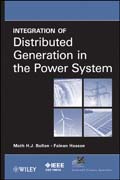
Integration of distributed generation in the power system
Bollen, Math H.
Hassan, Fainan
The integration of new sources of energy like wind power, solar-power, small-scale generation, or combined heat and power in the power grid is something that impacts a lot of stakeholders: network companies (both distribution and transmission), the owners and operators of the DG units, other end-users of the power grid (including normal consumers like you and me) and not in the least policy makers and regulators. There is a lot of misunderstanding about the impact of DG on the power grid, with one side (including mainly some but certainly not all, network companies) claiming that the lights will go out soon, whereasthe other side (including some DG operators and large parks of the general public) claiming that there is nothing to worry about and that it's all a conspiracy of the large production companies that want to protect their own interests and keep the electricity price high. The authors are of the strong opinion that this is NOT the way one should approach such an important subject as the integration of new, more environmentally friendly, sources of energy in the power grid. With this book the authors aim to bring some clarity to the debate allowing all stakeholders together to move to a solution. This book will introduce systematic and transparent methods for quantifying the impact of DG on the power grid. INDICE: 1. Introduction. 2. Sources of Energy. 2.1 Wind power. 2.2 Solar power. 2.3 Combined heat and power. 2.4 Hydropower. 2.5 Tidal Power. 2.6 Wave Power. 2.7 Geothermal Power. 2.8 Thermal Power Plants. 2.9 Interface with the grid. 3. Power system performance. 3.1 Impact of Distributed Generation on the Power System. 3.2 Aims of the power system. 3.3 Hosting Capacity Approach. 3.4Power Quality. 3.5 Voltage Quality and Design of Distributed Generation. 3.6 Hosting capacity approach for events. 3.7 Increasing the Hosting Capacity. 4. Overloading and losses. 4.1 Impact of Distributed Generation. 4.2 Overloading:Radial Distribution Networks. 4.3 Overloading: Redundancy and Meshed Operation. 4.4 Losses. 4.5 Increasing the Hosting Capacity. 5. Voltage magnitude variations. 5.1 Impact of Distributed Generation. 5.2 Voltage Margin and Hosting Capacity. 5.3 Design of Distribution Feeders. 5.4 A Numerical Approach to Voltage Variations. 5.5 Tap-changers with line-drop-compensation. 5.6 Probabilistic Methods for Design of Distribution Feeders. 5.7 Statistical Approach to Hosting Capacity. 5.8 Increasing the Hosting Capacity. 6. Power quality disturbances. 6.1 Impact of Distributed Generation. 6.2 Fast Voltage Fluctuations. 6.3 Voltage Unbalance. 6.4 Low-Frequency Harmonics. 6.5 High-Frequency Distortion. 6.6 Voltage Dips. 6.7 Increasing the Hosting Capacity. 7. Protection. 7.1 Impactof Distributed Generation. 7.2 Overcurrent Protection. 7.3 Calculating the Faults Current. 7.4 Calculating the Hosting Capacity. 7.5 Busbar protection. 7.6Excessive Fault Current. 7.7 Generator Protection. 7.8 Increasing the HostingCapacity. 8. Transmission System Operation. 8.1 Impact of Distributed Generation. 8.2 Fundamentals of Transmission System Operation. 8.3 Frequency Control, Balancing, and Reserves. 8.4 Prediction of Production and Consumption. 8.5 Restoration after a Black-out. 8.6 Voltage Stability. 8.7 Kinetic Energy and Inertia Constant. 8.8 Frequency Stability. 8.9 Angular Stability. 8.10 Fault Ride-Through. 8.11 Storage. 8.12 HVDC and FACTS. 8.13 Increasing the Hosting Capacity. 9. Conclusions.
- ISBN: 978-0-470-64337-2
- Editorial: John Wiley & Sons
- Encuadernacion: Cartoné
- Páginas: 547
- Fecha Publicación: 22/07/2011
- Nº Volúmenes: 1
- Idioma: Inglés
